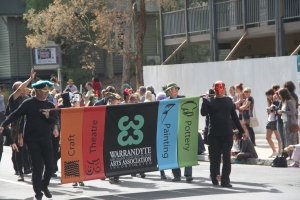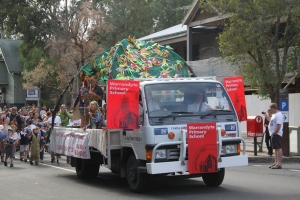by Danielle Wintle
Overview
Our hypothesis, that Warrandyte responds well to its learners, by providing a series of learning opportunities in areas of interest to the community such as arts, sustainability, fire risk, early childhood and recreational activities that are inclusive of the social, cultural, geographical and physical characteristics of the area, has been found to be accurate. In this area of study, the arts, we found that the community interests were being met by the numerous amounts of courses that are run and offered in the local community. Many people within the Warrandyte community participate in the art courses and they continue to participate year in and year out. This was evidence that the interest in the arts is still strong within the community.
This is an overview of Warrandyte’s vibrant community. We started with the history of the area and have tried to establish whether the art community is as strong today as it was in the past. We have looked at many artistic aspects of the area and collated my finding in a report to establish whether the community is still as interested in learning Art, as we believed that they would be, before the research started.

This photo is representative of a happy and in touch community in Warrandyte.
Art history in Warrandyte.
Warrandyte and its reputation as an artist’s colony began in the late nineteenth, early twentieth century. One of Australia’s most prominent art movements was the Heidelberg School painter’s. Warrandyte had many of the Heidelburg School painters living in the area including Clara Southern, Walter Withers, Harold Herbert, Jo Sweatman, Penleigh Boyd and Frank Crozier to name a few. Southern lived and painted in the area around the 1900’s. She had been trained at the National Gallery of Victoria Art School under Fredrick McCubbin and George Folingsby. It was due to her moving to Warrandyte, that many younger, less well known Heidelberg artists became captivated by the beauty of Warrandyte and eventually also settled into the area. (Percival, 1949) Warrandyte became a popular location for other artists because of the bush land and the Yarra River running through the centre of the township. Predominantly Warrandyte painter’s painted beautiful landscapes and some still life paintings. The Yarra River has inspired many paintings over the years and still continues to do so, with many artists that still gravitate to the area for inspiration.
In 1955, ‘The Warrandyte Arts Association (WAA)’ was formed. This group represented many forms of artists. Some were potters, painters, craft makers, musicians and theatre performers. This group saved the Mechanics Institute Hall on the corner of Mitchell Avenue and Yarra Street, from demolition and in turn fosters a vibrant art community and maintains a historical building for the benefit of all the people in the community today. (National Trust, 2013)
Another artistic group that was inspired by the natural beauty of Warrandyte was the ‘clay potters’. In 1958 a newly formed group, with Reg Preston, Phyl Dunn, Gus McLaren, Charles Wilton and Arthur Halpern established Potters Cottage. This was somewhere the potters could sell their wares and also exhibit their works. It was established with humble beginnings in a wattle and daub cottage. The founder’s aim was to create an interest in Australian pottery and this aim was fulfilled immediately. With it’s immediate success, Potters Cottage attracted other reputable potters in Kate Janeba, Elsa Arden and Sylvia Halpern. People from all over Australia came to visit and see the potters in action. The cottage became a popular weekend place to visit. The Potters Cottage prize began in 1965 and ran until 1982. In 1969 Potters Cottage moved to its current location, 321 Jumping Creek Rd, Warrandyte. (Pearson, R 1998) In 1969 The Potters Cottage School was built after many requests for tuition from people in the public. In 1970 the restaurant area was built and still remains today.
Artists still working in Warrandyte
There are many other creative people whom live in the Warrandyte precinct, many who blow glass and make jewelry, as well as, the potters, printmakers and painters. Many of these artists open their studios for the tourists and public to visit and see them at work. The community feel is rich, vibrant, friendly and sharing. We met with a local artist while visiting the historical society and she invited us to her studio to interview her and see what sorts of art she was producing. (Warrandyte historical society, 2013)
The local artist was born and raised in Brisbane. She studied drawing, painting and graphics at Brisbane Technical College under Margaret Olley. As she matured her artistic interests evolved and she became a potter. She met her husband, who is also an artist in Warrandyte, and eventually in 1978, she moved to Warrandyte to live. When asked about why they live in Warrandyte? Her response was that, “ With a river like the Yarra, why live anywhere else!” (Cherry Manders, 2013) She feels that the beauty of Warrandyte and the Yarra River is enough inspiration for herself and that she never struggles to find something creative to do. She also commented on the fact that because the community is full of artists that inspiration is never far away.
The local artist’s early career in Warrandyte included teaching ceramics to people at Potters Cottage. Many of her work can be seen on display in the Old Post Office, Warrandyte, 23, Boyde Street, work that we had the opportunity to see and were viewing when we met her. After a period of teaching she returned to her painting and gained a growing reputation in the painting world. This is especially due to her recent win of the Norma Bull Portraiture Prize in 2011. (Cherry Manders, 2013) The local artist has a love for colour and movement. She uses the river environment in Warrandyte and many of the flowers from her bush garden often in her work. Her passion for colour can be seen in her still life studies, landscapes and figure studies. She says she could not live anywhere else as Warrandyte is the place where much of her inspiration comes from.
There are many artisans living and working in Warrandyte. This is evident by the amount of galleries and shops in the main street offering hand made products, jewelry, sculpture, pottery and paintings to state a few. One of these galleries, The Stonehouse Gallery in Yarra Street was established in 1972. It is both owned and run by artists in the area. This allows visitors a chance to ask questions about the artworks and learn about who the artists are. The Stonehouse Gallery again is a beautifully preserved old historical building displaying local works in an ambient setting. The building was originally a gospel church, but now houses these beautiful artworks. The artists were very generous with their time and information and this is representative of the community as a whole in Warrandyte. The impression left on me was that the community is trying to maintain the historical aspect of the township with the preservation of old buildings however the contemporary art sold on the premises gives a modern feel to the area.
Further studies of the area evidenced the existence of many other working studios in Warrandyte, which also have constant exhibitions showcasing local art. With such a rich artistic community on display, finding out about the people as learners in the area and what sorts of activities, creatively, they were interested in being taught will be fascinating. Finding out, whom are the people teaching these courses was of great interest. The results of these findings are presented in the following report.
Artistic courses on offer in Warrandyte.
Warrandyte’s Neighbourhood House supports the local community with many artistic courses being offered at various times throughout each year. They are committed to the community as learners and try to provide individuals with a place not only to learn but also to make friends, feel welcome and provide links in to the community.
Nancy Johnson a local artist uses the Neighbourhood house to teach young boys and girls to draw. Although Nancy has no formal training as a teacher she is well respected in the area for her artwork. The drawing classes are offered after school to children aged between six and ten. There are approximately ten students in the class and there are usually more girls than boys. Having classes for children of these ages indicates that the community has a need for their children to start learning early, about art, with the simple task of learning to draw.
Another local artist, Dorothy Field teaches painting with watercolours. Once again the teacher has no formal teaching training, but is well regarded in the community for her artwork. This indicates that a reputation within the community will hold you in good stead. People who participate in this course tend to be retired women between fifty and sixty years old. Occasionally there is someone in there forties participating. Men do not seem attracted to participating in this course.
Other courses that are offered at the Warrandyte Neighbourhood house are felting workshops, busy needles workshops and creative writing and poetry. The only course that has a qualified teacher teaching it is the creative writing and poetry class. The felting and busy needles again have local artists heading the class. These classes are not just designed for advanced learners, but also for those who are just starting out. Classes are offered to anyone who wants to attend. The students sometimes contribute their work to the community. The felting and busy needles workshops attract Warrandyte’s older learners and there are one hundred percent women in the classes. These classes are only run once a year as the demand is not there all year around.
School learning environments
Warrandyte Primary School was established in the 1850’s as a result of families moving to the area for the gold mining period. Over the years the School has been able to maintain a rich historical feel around the school with the use of student’s artistic talents. Over a one-year period the whole school was involved in an artistic curriculum, which also taught the students about Warrandyte’s history. This was done in the form of a large mosaic, which now, adorns the school buildings. The children were in charge of the design and they also created the mosaics. Cohwey (2006) describes how a single project is able to affect a whole school and their various families in a positive way. She is impressed with teachers that empower children to take on responsibilities. This can be seen at Warrandyte Primary School with their mosaic project. While this project was being made the students at all levels, not only did they learn about the techniques behind building a mosaic and the design aspect of such, but the students also learnt about the rich historical aspect of Warrandyte as a township.
We spoke briefly to a parent at Warrandyte primary school who said that her children absolutely loved participating in their art classes. The children even said it would be great if they were allowed to do more art every week. Indicating a real passion for art still exists within the community. (Parent from Warrandyte P.S, 2013)
Andersons Creek primary school also in Warrandyte has been able to integrate a valued art curriculum into their school. The students are encouraged to learn through experience and therefore to become independent in their creativity. Anderson’s Creek teachers encourage students to not conform but to extend their imagination and creativity, to think outside the box. The year six students work as a whole group their art class to create artworks that will be permanently displayed in the school grounds. This not only encourages students to learn in a group environment but also to problem solve together. This practice is similar to what Freire (2000) argued was appropriate for learners. He found the “banking concept”, where students are treated as empty and ignorant vehicles as stifling to their individual creativity, and they’re critical thinking processes. Anderson Creek Primary School teaches its students as independent people with needs that are individual but that also encourages the students to work in an environment that is a whole. They do not teach their students by feeding information to them and expect that they just remember what is being said to them and think that is what learning is about. They have a very interactive program where all students’ needs are hopefully being addressed. (Andersons Creek P.S, 2013)
Warrandyte high school the only high school in the area, has a varied curriculum, but seems to pride itself on their achievements in the Art sector also. Simply visiting their website one can see how important their art curriculum is. Under the heading Student Programs there are many awards listed. Those listed were mainly for the students in the senior years at the school and these students would average in age at about 17 years old. (Warrandyte High School, 2013)
Some of the achievements listed are winning the Premiers award for VCE multi media and Studio Arts. The school has had many students selected for the Top Design between 2007-2012. They also had an entrant into the Top arts, which is held at the NGV annually in 2010. Not only did this student gain entry into this prestigious award for students, but also 14,000 people viewed the work and it was chosen as third overall in the People Choice award for that year. Warrandyte High School not only excels in studio art, but it also excels in digital animation. In 2010 in the senior category they won the VIITA animation award. (Warrandyte High School, 2013) These achievements in the Arts indicate that the school is offering a curriculum that matches the community interests, especially in the arts.
The senior years seem to excel in the arts, however the school and community also encourage the junior students extensively. In the junior years there is quite a lot support given from external forces outside the school. The Rotary Club and Lions club of Warrandyte encourages young students with annual competitions. Many artworks are on display throughout Warrandyte, such as the sculpture in front of the Police station in Warrandyte. The junior years are aged between 12 and 16 years old and those who participate are both boys and girls. (Warrandyte High School, 2013) This indicates again that the community values its artistic heritage and still wants to encourage the young to be creative, by running many art competitions in the area.
Overall findings
Warrandyte’s artistic heritage continues to be an influence on the social and cultural characteristics in today’s township. There are many artists living in the area utilizing, as well as assisting in the community, either by teaching craft, pottery or art. From early childhood through to their late seventies, Warrandyte residents participate extensively in different art courses that are offered within the community. We see this as the community still appreciating the arts and its history in the area. There are also many people who visit the area to see the artist’s works either in exhibition or to purchase, which would help with the tourist dollar coming into the town and continue the historic pathway that was established in the 1800’s. People, who live in Warrandyte are happy to help, share and assist others within the community. This shows how strong the community values one another. After the time spent in the suburb, we found that those spoken with would like to preserve the town and continue it’s historic artistic heritage into the future. We found the people to be proud of Warrandyte’s heritage and that many were very knowledgeable about their town.


